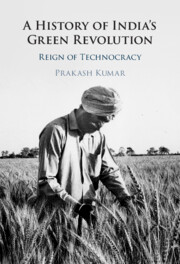Refine search
Actions for selected content:
13574 results in History of science and technology
Bibliography
-
- Book:
- A History of India's Green Revolution
- Published online:
- 07 August 2025
- Print publication:
- 21 August 2025, pp 207-233
-
- Chapter
- Export citation
Index
-
- Book:
- A History of India's Green Revolution
- Published online:
- 07 August 2025
- Print publication:
- 21 August 2025, pp 234-238
-
- Chapter
- Export citation
1 - Colonial Technocracy
-
- Book:
- A History of India's Green Revolution
- Published online:
- 07 August 2025
- Print publication:
- 21 August 2025, pp 27-59
-
- Chapter
- Export citation
Dedication
-
- Book:
- A History of India's Green Revolution
- Published online:
- 07 August 2025
- Print publication:
- 21 August 2025, pp v-vi
-
- Chapter
- Export citation
Tables
-
- Book:
- A History of India's Green Revolution
- Published online:
- 07 August 2025
- Print publication:
- 21 August 2025, pp ix-x
-
- Chapter
- Export citation
5 - Realization of Modernization Dreams?
-
- Book:
- A History of India's Green Revolution
- Published online:
- 07 August 2025
- Print publication:
- 21 August 2025, pp 159-192
-
- Chapter
- Export citation
2 - Development through People’s Participation
-
- Book:
- A History of India's Green Revolution
- Published online:
- 07 August 2025
- Print publication:
- 21 August 2025, pp 60-94
-
- Chapter
- Export citation
Reviews
-
- Book:
- A History of India's Green Revolution
- Published online:
- 07 August 2025
- Print publication:
- 21 August 2025, pp ii-ii
-
- Chapter
- Export citation
Preface
-
- Book:
- A History of India's Green Revolution
- Published online:
- 07 August 2025
- Print publication:
- 21 August 2025, pp xi-xi
-
- Chapter
- Export citation
Contents
-
- Book:
- A History of India's Green Revolution
- Published online:
- 07 August 2025
- Print publication:
- 21 August 2025, pp vii-vii
-
- Chapter
- Export citation
4 - A Decolonizing Perspective and Technocracy in Uttar Pradesh
-
- Book:
- A History of India's Green Revolution
- Published online:
- 07 August 2025
- Print publication:
- 21 August 2025, pp 128-158
-
- Chapter
- Export citation
Introduction
-
- Book:
- A History of India's Green Revolution
- Published online:
- 07 August 2025
- Print publication:
- 21 August 2025, pp 1-26
-
- Chapter
- Export citation
Scientific expertise in early international negotiations on climate change: Bert Bolin and the IPCC
-
- Journal:
- The British Journal for the History of Science , First View
- Published online by Cambridge University Press:
- 15 August 2025, pp. 1-23
-
- Article
-
- You have access
- Open access
- HTML
- Export citation
Aristotelianism, alchemy and corpuscularianism in the thirteenth century: the problem of substantial form and its corpuscular solution
-
- Journal:
- The British Journal for the History of Science , First View
- Published online by Cambridge University Press:
- 15 August 2025, pp. 1-17
-
- Article
-
- You have access
- Open access
- HTML
- Export citation
Fusion divided: what prevented European collaboration on controlled thermonuclear fusion in 1958
-
- Journal:
- The British Journal for the History of Science , First View
- Published online by Cambridge University Press:
- 13 August 2025, pp. 1-19
-
- Article
-
- You have access
- Open access
- HTML
- Export citation

A History of India's Green Revolution
- Reign of Technocracy
-
- Published online:
- 07 August 2025
- Print publication:
- 21 August 2025
Andreas W. Daum, Alexander von Humboldt: A Concise Biography Princeton, NJ: Princeton University Press, 2024. Pp. 224. ISBN 978-0-691-24736-6. £20.00 (hardcover).
-
- Journal:
- The British Journal for the History of Science , First View
- Published online by Cambridge University Press:
- 21 July 2025, pp. 1-2
-
- Article
-
- You have access
- HTML
- Export citation
Joshua Blu Buhs, Think to New Worlds: The Cultural History of Charles Fort and His Followers Chicago: University of Chicago Press, 2024. Pp. 384. ISBN 978-0-226-83148-1. $35.00 (cloth).
-
- Journal:
- The British Journal for the History of Science , First View
- Published online by Cambridge University Press:
- 21 July 2025, pp. 1-2
-
- Article
-
- You have access
- HTML
- Export citation
Thomas S. Mullaney, The Chinese Computer: A Global History of the Information Age Cambridge, MA: MIT Press, 2024. Pp. 376. ISBN 978-0-262-04751-7. $34.95 (hardcover).
-
- Journal:
- The British Journal for the History of Science , First View
- Published online by Cambridge University Press:
- 21 July 2025, pp. 1-2
-
- Article
-
- You have access
- HTML
- Export citation
Peter J. Bowler, Evolution for the People: Shaping Popular Ideas from Darwin to the Present Cambridge: Cambridge University Press, 2024. Pp. 308. ISBN 978-1-009-44899-4. £25.99 (paperback).
-
- Journal:
- The British Journal for the History of Science , First View
- Published online by Cambridge University Press:
- 03 July 2025, pp. 1-2
-
- Article
-
- You have access
- HTML
- Export citation
